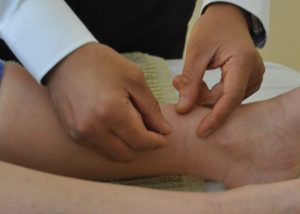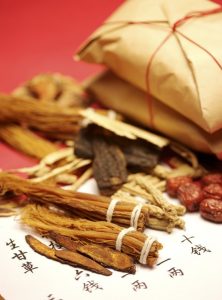Period pain, also known as dysmenorrhea, can be a frustrating and debilitating condition for many women. Traditional Chinese Medicine (TCM), including acupuncture, offers a holistic and natural approach to managing period pain. Almond Wellness Centre acupuncture clinics in Melbourne provide personalised TCM treatment plans to manage dysmenorrhea symptoms.
Table of Centents

acupuncture for period pain
Acupuncture is a central component of TCM treatment. It involves the insertion of thin needles into specific points on the body to stimulate the flow of Qi and blood, which is believed to help alleviate period pain. A recent study published in the Journal of Obstetrics and Gynaecology Research found that acupuncture was an effective treatment for primary dysmenorrhea (1). Furthermore, the study found that acupuncture had fewer side effects than conventional pain medication.
How Traditional Chinese Medicine (TCM) manage dysmenorrhoea period pain
In Traditional Chinese Medicine, period pain is typically attributed to an imbalance of Qi (pronounced “chee”), which is the body’s vital energy. Before treatment, patients are assessed by a qualified practitioner to determine the underlying cause of their symptoms. Based on this assessment, a personalised treatment plan is created to address the patient’s unique needs. The treatment plan may include acupuncture, herbal medicine, and other TCM modalities.
Acupuncture and dysmenorrhoea period pain
Acupuncture is one of the treatments used in Chinese medicine to rebalance Qi and alleviate period pain. Acupuncture treatment for period pain typically involves several sessions over a period of weeks, depending on the severity and duration of the symptoms. During each session, the practitioner will insert needles into the designated acupuncture points, which may cause a mild sensation of pressure or warmth. The needles will be left in place for 15-30 minutes, during which time the patient will typically rest comfortably.
Commonly used acupuncture points for period pain
Acupuncture points used to treat period pain include those located on the lower abdomen, lower back, and legs. The specific points used will depend on the individual’s symptoms and their underlying condition according to traditional Chinese medicine diagnosis. Acupuncture points commonly used to treat period pain include:
Zigong (Extra point located four finger-widths below the belly button on the midline): This point is believed to regulate the uterus and alleviate menstrual pain.
Sanyinjiao (SP6, located four finger-widths above the inner ankle bone on the back of the shin): This point is believed to regulate the uterus, promote blood circulation, and alleviate menstrual pain.
Guanyuan (CV4, located two finger-widths below the belly button on the midline): This point is believed to tonify the Qi and blood of the lower abdomen, regulate menstruation, and alleviate menstrual pain.
Chinese herbal medicine and dysmenorrhoea period pain

Chinese herbal medicine
In addition to acupuncture, other Chinese medicine treatments such as herbal medicine, cupping, and dietary therapy may also be recommended to help manage period pain. Herbal medicine is often prescribed alongside acupuncture to further manage dysmenorrhea symptoms.
Commonly used Chinese herbs and herbal formulas
Chinese herbs such as dong quai, chuan xiong, and bupleurum are commonly used to regulate the flow of Qi and blood, which can help alleviate period pain. Here are examples of some commonly used Chinese herbal formulas and acupuncture points for period pain:
Gui Zhi Fu Ling Wan (Cinnamon and Poria Pill to Regulate the Menses): This formula is used to promote blood circulation, regulate menstruation, and alleviate cramping and pain. It is typically composed of cinnamon, poria, peony, moutan, and other herbs.
Xiao Yao Wan (Free and Easy Wanderer Pill): This formula is used to regulate the liver, nourish the blood, and promote Qi circulation, which can help to alleviate menstrual pain and emotional stress. It is typically composed of bupleurum, peony, angelica, and other herbs.
Suan Zao Ren Tang (Sour Jujube Decoction): This formula is used to nourish the liver blood and calm the spirit, which can help to alleviate menstrual pain, irritability, and insomnia. It is typically composed of sour jujube seed, poria, and other herbs.
Other natural remedies for period pain
In addition to acupuncture and herbal medicine, our acupuncture clinics also offers lifestyle advice to help manage dysmenorrhea symptoms. This advice may include dietary recommendations, exercise, and stress management techniques.
Overall, TCM offers a holistic and personalised approach to managing dysmenorrhea. It is important to consult with a registered practitioner of Chinese medicine to determine the most appropriate treatment plan for your individual needs.
Almond Wellness Centre
Almond Wellness Centre acupuncture clinics in Melbourne provides natural holistic treatment options that can help alleviate the pain and discomfort associated with dysmenorrhea.
As each person is different, if you or someone you care about is dysmenorrhoea period pain, and would like to explore the potential benefits of Chinese medicine acupuncture, please don’t hesitate to contact us. Our fully qualified registered acupuncture Chinese medicine practitioners in both Coburg Chinese medicine clinic and Ringwood Chinese medicine clinic are here to provide information and assistance. We will assess your specific condition, take into account your medical history, and develop a treatment plan tailored to your needs.
References
Liu, Z., Liu, Y., Xu, H., He, L., & Chen, Z. (2018). Acupuncture for primary dysmenorrhea: A systematic review and meta-analysis of randomized controlled trials. Journal of Obstetrics and Gynaecology Research, 44(6), 1014-1023. doi: 10.1111/jog.13631.
These studies suggest that acupuncture and TCM can be effective in managing period pain and other gynecological conditions.
Armour, M. (2015). The effectiveness of acupuncture in the treatment of primary dysmenorrhea : a mixed methods study.
TCM acupuncture, irrespective of treatment timing, provided significant clinical benefits for women with primary dysmenorrhea, with reductions in pain severity, duration, secondary menstrual symptoms and analgesic intake.
Mike Armour, etl July 12 2017. The role of treatment timing and mode of stimulation in the treatment of primary dysmenorrhea with acupuncture: An exploratory randomised controlled trial.
Conclusion of this research: acupuncture treatment reduced menstrual pain intensity and duration after three months of treatment and this was sustained for up to one year after trial entry. The effect of changing mode of stimulation or frequency of treatment on menstrual pain was not significant. This may be due to a lack of power. The role of acupuncture stimulation on menstrual pain needs to be investigated in appropriately powered randomised controlled trials.
V. Iorno,etl. Acupuncture Treatment of Dysmenorrhea Resistant to Conventional Medical Treatment. Evid Based Complement Alternat Med. 2008 Jun; 5(2): 227–230.
Acupuncture for dysmenorrhoea. Smith CA, etl.Cochrane Database Syst Rev. 2016 Apr 18;
Due to the large volume of low-quality studies, this Cochrane review found there is insufficient evidence to demonstrate whether or not acupuncture or acupressure are effective in treating primary dysmenorrhoea,
Zhu X, Hamilton KD, McNicol ED. Acupuncture for pain in endometriosis. Cochrane Database Syst Rev. 2018;5(5):CD012617. doi: 10.1002/14651858.CD012617.pub2.
Chiu HY, Pan CH, Shyu YK, et al. Effectiveness of acupuncture in women with polycystic ovarian syndrome undergoing in vitro fertilisation or intracytoplasmic sperm injection: a systematic review and meta-analysis. Acupunct Med. 2020;38(1):17-28. doi: 10.1177/0964528419878323.
Smith CA, Armour M, Zhu X, Li X, Lu ZY, Song J. Acupuncture for dysmenorrhoea. Cochrane Database Syst Rev. 2016;4(4):CD007854. doi: 10.1002/14651858.CD007854.pub3.
Lian F, Li Y, Xie RJ, Wang J, Zhang Y, Bai J. Effects of Chinese medicine for promoting blood circulation and removing blood stasis in treating patients with dysmenorrhea: a systematic review. Evid Based Complement Alternat Med. 2016;2016:8582727. doi: 10.1155/2016/8582727.
Shi GX, Yang XM, Liu CZ, et al. Acupuncture for chronic low back pain: a multicenter, randomized, patient-assessor blind, sham-controlled clinical trial. Spine (Phila Pa 1976). 2019;44(8):592-601. doi: 10.1097/BRS.0000000000002885.
